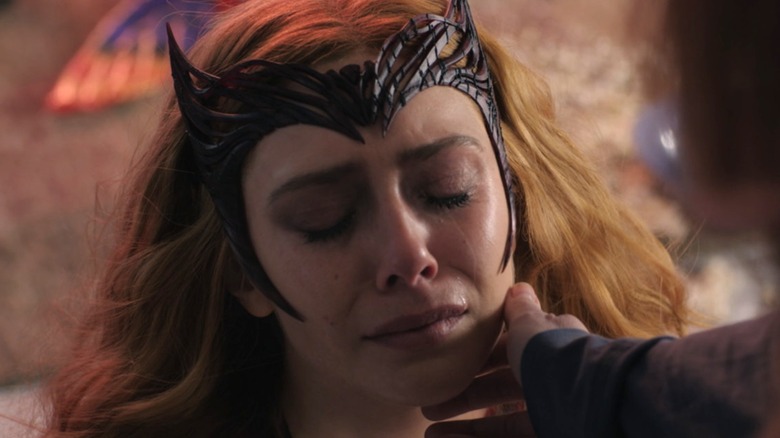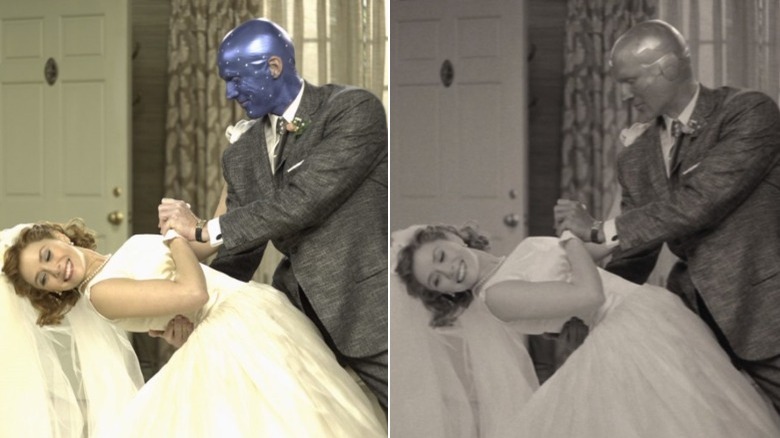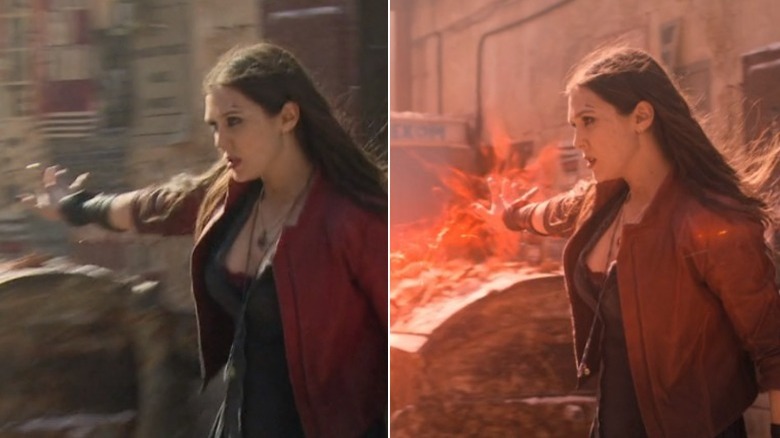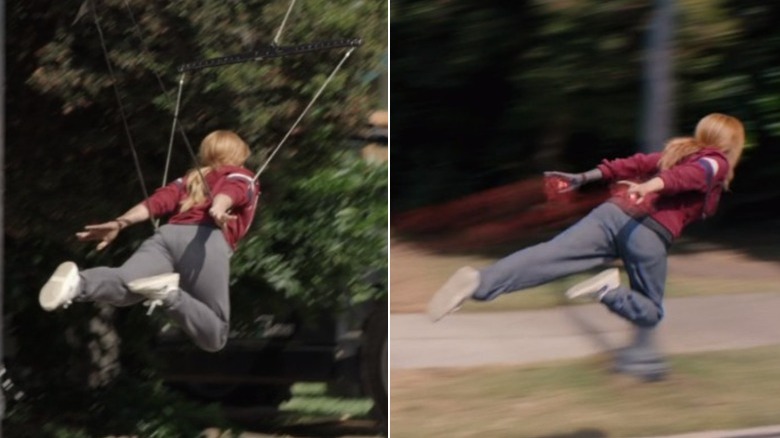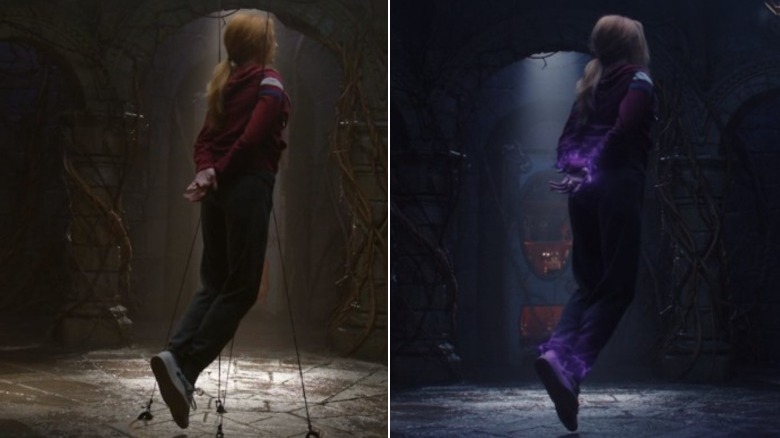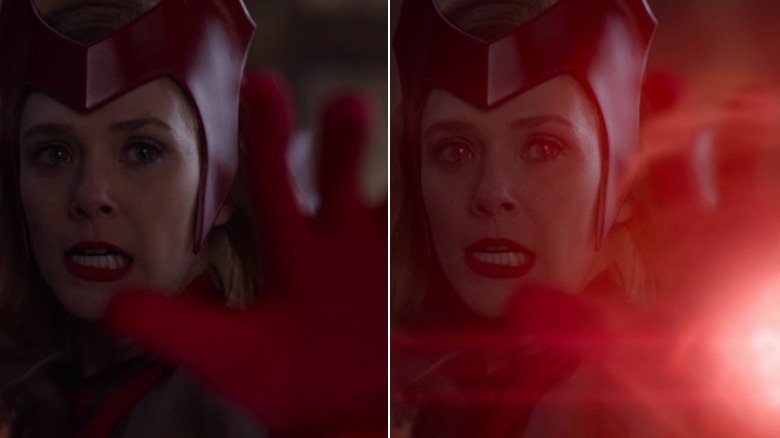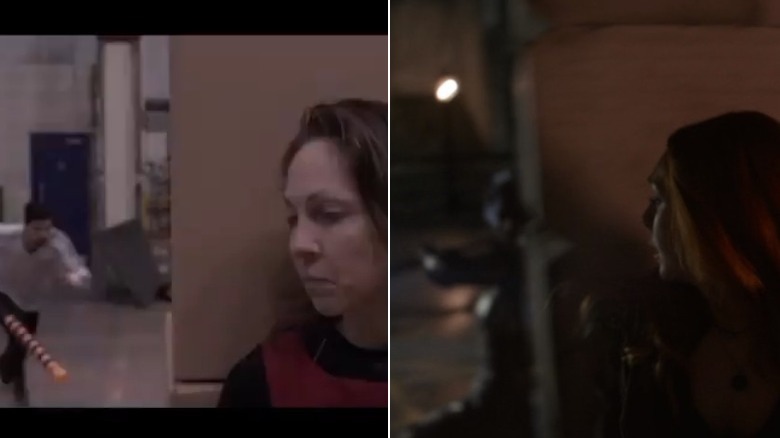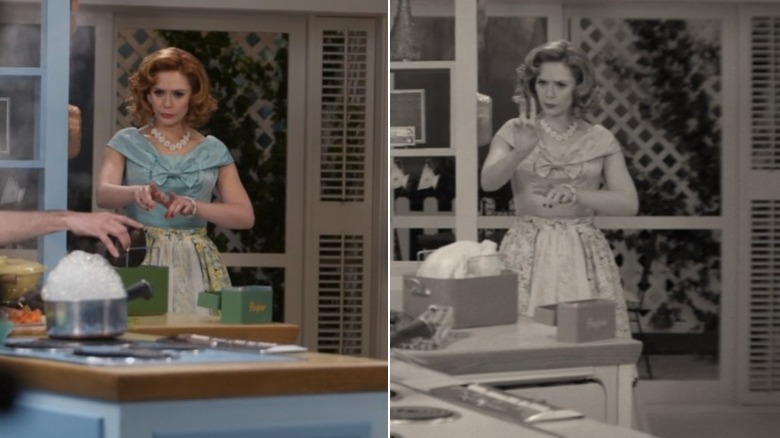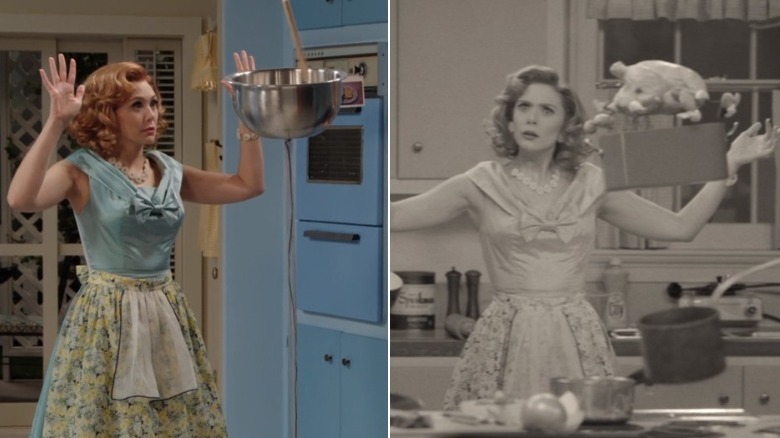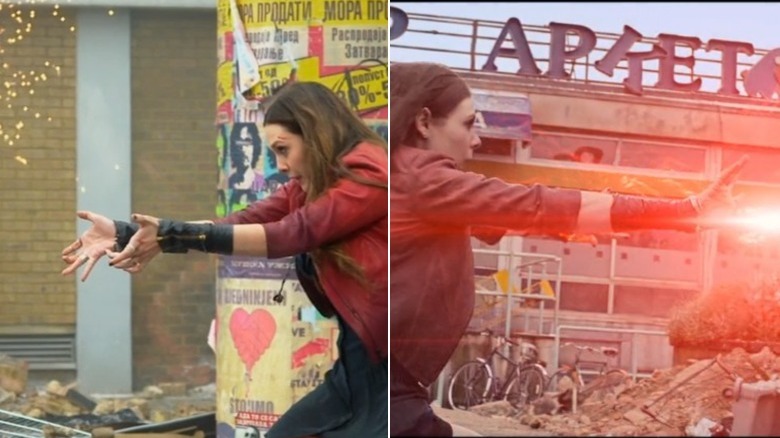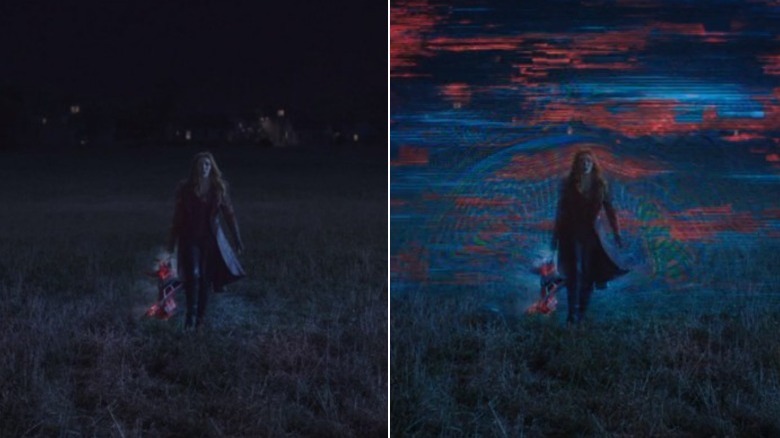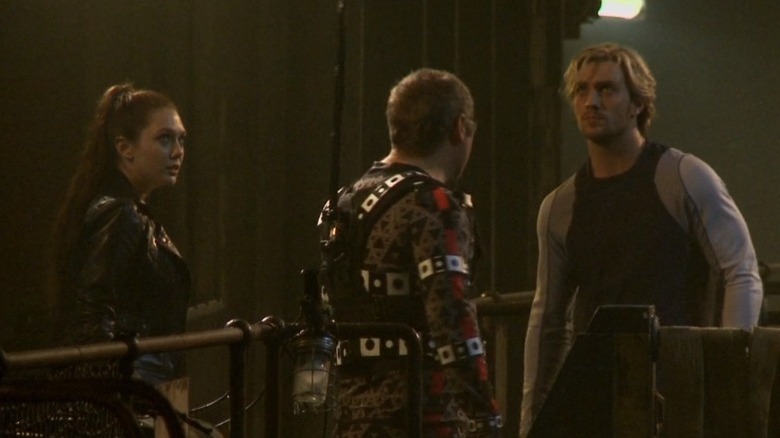What These Scarlet Witch Scenes Look Like With No Special Effects
Critics and audiences tend to agree that the Scarlet Witch (Elizabeth Olsen) is the most powerful Avenger in the MCU. Such awesome witchy powers on display every time Wanda Maximoff appears require an awful lot of visual effects. In fact, Paul Bettany assured audiences that the Disney+ series "WandaVision" actually exceeded "Avengers: Endgame" when it came to the number of VFX shots, and they weren't all explosions. You might be surprised at how many simple shots in "WandaVision" required elaborate VFX, and how many elaborate shots relied on old-school special effects.
It might seem obvious that without the visual representation of her powers, Wanda just looks like Olsen standing in front of a green screen. However, there's more to it than that. There's a fascinating story behind almost every effect — like why Wanda's magic looks cooler at night, or why Olsen wasn't allowed to look at her "Avengers: Age of Ultron" co-star James Spader. But perhaps the wildest story of all is what happened after Olsen's stunt double smashed through a restaurant window. Let it never be said that visual effects work is boring. Anyway, here are what these Scarlet Witch scenes look like with no special effects.
Vision is painted blue in certain scenes
"WandaVision" includes a lot of VFX shots that just consist of Wanda and Vision (Paul Bettany) sitting and talking. That's because every shot of Vision in his synthezoid form is a special effect. Most viewers "assume that Paul Bettany's wearing headgear," Ryan Freer from the VFX team of "WandaVision" told SyFy Wire. After all, that's how they did it in previous MCU films. Thankfully for Bettany — who told USA Today this headgear was extremely "uncomfortable" — Marvel decided to give him a digital prosthetic for the TV series. In "Marvel Studios Assembled: The Making of WandaVision," visual effects supervisor Tara DeMarco explained that most of Vision's head is actually made up of CG elements added in post-production — except for Vision's face, which is Bettany's real face painted red.
Of course, Vision's face can't look red in the black-and-white episodes of "WandaVision." For those shots, Bettany actually wore blue makeup, but nobody's the wiser. When DeMarco first began working on "WandaVision," she converted some sample footage from "Captain America: Civil War" into black and white, and discovered that Vision didn't really look red. "It was too dark, and you couldn't really read him," she told Film School Rejects. "During the '50s and '60s, actresses would actually use blue makeup, blue lipstick, so their lips would appear red," explained Jen Underdahl, Marvel's vice president of visual effects, in an interview for "Assembled." Marvel simply did the same thing for Bettany, who must be used to Vision's strange-looking makeup and costumes by now.
Wanda's powers use the same visual language as Pietro's
Wanda and her brother Pietro (Aaron Taylor-Johnson) have totally different powers, but their special abilities still have something in common. Conceptual artist Paolo Giandoso from VFX studio Trixter Film explained to ComicBook.com that Marvel wanted to give Wanda and Pietro's powers the same visual language, since they're twins. They both have what Giandoso called an "emission pattern" — for Pietro, that's the silvery trail he leaves behind when he runs; for the Scarlet Witch, that's the traces radiating outward from her hands when she casts a spell. According to Giandoso, director Joss Whedon insisted that "this light emission would not appear smoky or wispy in any way," because it was meant to be "otherworldly" rather than a substance from the physical world.
Of course, this CG effect was paired with a tangible, practical element — Wanda's physical gestures. In an interview with Empire, Elizabeth Olsen said she worked with choreographer Jenny White to give fluidity and structure to Wanda's movements when she's using magic. Olsen even invented a word to refer to these dance-like motions — she calls it "wiggly-woo." According to Olsen, it felt strange at first to be basically dancing while the other actors were throwing punches. She told /Film, "[During rehearsal] everyone's getting beat up, and [Jenny] and I are just doing weird moves and pretending like we're making things shoot out of our hands."
Elizabeth Olsen spent a lot of time in a harness
Sorry if we're spoiling the magic for anyone, but Elizabeth Olsen can't actually fly. In "WandaVision," she required the use of harnesses to soar through the air, just like the rest of us mere mortals. Olsen told "Marvel Studios Assembled" that the flying sequences in "WandaVision" were quite possibly the largest she'd seen in her time at Marvel. Olsen joked, "We're always harnessed," insisting that she and the other lead actors basically spent the whole time in the air for the last month of production.
Olsen already had some experience flying from previous Marvel movies. According to Rolling Stone, she offered advice to Kathryn Hahn, who famously portrayed Agatha Harkness, on how to best angle her body in the harness so she wouldn't end up with a sore back afterward. Even then, the flying sequences weren't exactly a piece of cake for Hahn. She explained to Rolling Stone, "I had to really carefully plot out my bathroom trips because it was a 45-minute process." Even Olsen admitted in "Assembled" that she had it easy compared to Hahn, who was wearing "a ridiculous costume that [was] very uncomfortable to harness and fly in."
The colors of WandaVision were carefully chosen
Colors are everything in the MCU. After all, there's an Infinity Stone for every color of the rainbow.
When introducing Agatha Harkness, the creators of "WandaVision" couldn't choose just any color for her magic. "There's a color palette in the Marvel Universe, and we had to be very careful not to cross-pollinate the color," VFX supervisor Ralph Maiers told Polygon, explaining that his team needed to visually distinguish the witch's powers from those of Doctor Strange or Hela. "We stayed out of the reds, because that's Scarlet Witch's world, and we stayed out of violet, because that's somebody else's world. We had to stay in these deeper purples." Maiers added that Marvel considered giving each witch in Agatha's coven a different color for their magic before realizing that would only divert attention from Agatha and Wanda.
In the scenes with Wanda, Marvel's VFX department needed to be careful with the lighting and color choices. The Scarlet Witch's powers don't look as striking in broad daylight, according to the Paolo Giandoso interview with ComicBook.com. In fact, Giandoso said sometimes Wanda's red balls of energy would appear "more light pink or yellow than red." That's why Trixter Film made sure that most of Wanda's spellcasting in "Age of Ultron" happened against a somewhat dark background, or at least in a setting with a lot of colors that would contrast the red light.
The look of Wanda's powers has evolved over time
When Wanda was first introduced in "Age of Ultron," her magic was meant to be ethereal and stealthy. Paolo Giandoso, who worked on the concept art for Wanda, told ComicBook.com that he wanted to stay away from the "opaque, bloody form of energy" of the Aether from "Thor: The Dark World." Instead, he wanted an effect that suited the Scarlet Witch.
When it eventually came time to design the look of Agatha's magic, Marvel needed to ensure it was consistent with Wanda's style of witchy magic, while still making Agatha's style unique. Agatha's magic "needed to be a little darker and scarier," Ralph Maiers told Polygon, so they designed Agatha's magic to resemble tendrils — the better to slither into your mind and steal your magic, my dear!
Of course, Wanda's powers were updated a little to match. "In 'Age of Ultron,' her effects are a little more orange-y and wispy," Maiers explained. But in "WandaVision," the Scarlet Witch's magic starts to take on the tendril-like qualities of Agatha's. This leaves viewers with the uneasy feeling that Wanda is becoming more and more like her nemesis.
The Scarlet Witch's stunt double practiced her moves in pre-viz
If you're wondering why the Avenger in the photo on the left doesn't look like Elizabeth Olsen, that's because she isn't. That would be CC Ice, Elizabeth Olsen's stunt double since "Infinity War." According to an interview with The Marvelous Madames, Ice has been fascinated with stunt work ever since she would climb trees and jump from high places for fun as a kid. "I was testing stunts when I was little," she told St. Louis Public Radio. "I just didn't know what it was called."
On Instagram, Ice shared her work on a fight sequence from "Infinity War" filmed during the pre-viz stage to choreograph the action and visualize the shots. Later, Ice traveled to Scotland to shoot it for real. She told The Marvelous Madames that this sequence contains what she considers the coolest stunt she's done in the entire MCU — the moment when Wanda crashes through the window of a restaurant. The restaurant actually exists, and Ice recalls that at one point they hung a sign in the window that read, "As seen in 'Avengers: Infinity War.'" Ice was more than happy to tell customers, "That was my body going through that window!"
WandaVision contains some low-tech special effects
Don't get us wrong — explosions are nice, but they don't quite have the same charm as some good old-fashioned effects. "WandaVision" director Matt Shakman wanted the show's early episodes to capture the feel of sitcoms from the mid-20th century. "We wanted to shoot it the way they shot it," he said in an interview for "Marvel Studios Assembled: The Making of WandaVision," and nowhere is the sitcom influence more apparent in the visual effects.
Olsen recalled filming a scene from Episode 3 in which Wanda's coat keeps magically changing. There was no CGI involved here. Instead, as she explained in "Assembled," they used a classic jump cut. "We'd have to freeze. And then somebody would come on and put on my coat," and then they would resume filming.
Sometimes, even a jump cut would be "too smooth," according to visual effects supervisor Ryan Freer in SyFy Wire. For instance, when Freer's effects team inserted Wanda and Vision's new wedding rings in between shots, the effect looked too clean. To draw more attention to this period-accurate special effect, Marvel needed to shift the couple's hands ever-so slightly so the change would be more noticeable. Freer admitted it was challenging to create effects that matched the very high standards of the MCU, but also resembled relatively cheap effects from old sitcoms.
WandaVision used wires like Bewitched
Elizabeth Olsen's favorite special effect from "WandaVision" was not, as you might expect, a flying sequence or a CG creation. She told BuzzFeed that she was impressed by the mere sight of Marvel's puppeteers maneuvering a dish towel to make it seem like it was drying a cup by itself.
In the first episode of "WandaVision," for instances of Wanda making objects float around her kitchen, Marvel's visual effects team decided to use techniques that would be a throwback to the quintessential '60s supernatural sitcom "Bewitched." That is, they relied on wires, puppetry, and magnets "to make things spin," Elizabeth Olsen told CBR.
For the "Marvel Studios Assembled" episode about "WandaVision," Matt Shakman described how he first pitched the idea of "Bewitched"-style effects to his special effects coordinator, Dan Sudick. Shakman admitted, "I didn't know if he was gonna like the idea, or he'd be like, 'What're you talking about?! I blow things up!'" As it turned out, Shakman was in luck. Not only was Sudick game for this idea, but it happened to be right up his alley, since he had been personally trained by the special effects team of "Bewitched."
Sokovia was filmed in several different locations
Thankfully, Marvel Studios didn't trash a whole Eastern European town in order to film the Battle of Sokovia in "Avengers: Age of Ultron." Instead, they trashed some soundstages and a block of empty buildings in London, which we think was a significantly better strategy.
The Sokovia we see in the final film is actually a combination of multiple locations. In an interview for "From the Inside Out: Making of Avengers: Age of Ultron," executive producer Jeremy Latcham explained, "Sokovia previously was in Italy. Sokovia's been onstage. Sokovia's kind of all over the place." Production designer Charles Wood added that they were "lucky" to find the location in London, as most prospective shooting sites wouldn't have been okay with Marvel's pyrotechnicians detonating over 1200 consecutive explosions.
Later in the same featurette, Elizabeth Olsen admitted, "I really loved that set." She appreciated all the careful detail that had gone into a set that was only going to be destroyed. There was a pair of statues that lost their arms midway through filming, Olsen recalled, and there was even a jungle gym designed in the shape of a tank, which she thought was hilarious.
The Hex barrier is designed to look like a TV
Just like everything else in the Scarlet Witch's world, the barrier around Westview often referred to as "the Hex" is inspired by sitcoms. Specifically, the design of Wanda's wall is drawn from "the language of television," says Tara DeMarco in "Marvel Studios Assembled." DeMarco and the other VFX wizards referenced details such as "the pixelization you would get when you zoomed way into an old TV," and then used those to inform the shimmering and distortion of the Hex.
As the story progresses from '50s-era sitcoms to 21st-century shows, so does the Hex. In early episodes, the distortion resembles an old-school CRT television when it malfunctions. By the last episode, the Hex shows what visual effects supervisor Julien Héry calls "more advanced glitches related to compression artifacts or loss of signal" – the kind of glitches we see in present-day TVs.
"The wall is also influenced by Wanda's emotional state," said Marion Spates, another visual effects supervisor on "WandaVision." He told Art of VFX that "in [the fourth episode] when you first see the wall from the outside it is a calm blue, but in the final moments when Wanda is angry, it is a dark red."
Olsen wasn't allowed to look at James Spader's face
Ultron (James Spader) is not nearly as menacing when you see how he looks without special effects. The 7-foot-tall android is actually nothing more than a regular-sized actor in a motion-capture suit. Mark Ruffalo, who had previously worn a mo-cap suit as the Hulk in the first "Avengers" film, helped show Spader the ropes. "It's ridiculous," Ruffalo said in an interview. "We're wearing these very unflattering suits."
Spader's mo-cap suit had a long pole rising up from his back. At the top were two glowing red lights, meant to mark where Ultron's eyes would be in the final film. Elizabeth Olsen recalls needing to crane her neck when filming her scenes with Spader, since the Scarlet Witch was supposed to be looking Ultron in the eyes. "During a take, we'd have to look three feet above his head," Olsen explained in an interview for "Making of 'Avengers: Age of Ultron.'" She added that the rule was "so irritating ... he was doing so much that you wanted to watch." Olsen joked that she spoiled quite a few takes because her eyes kept darting downward. Of course, with a performer as magnetic as James Spader, it's hard to look away.
